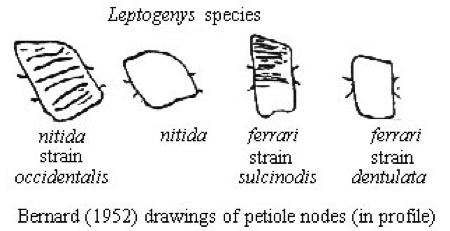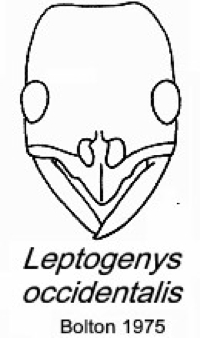Leptogenys occidentalis Bernard
  Type location Guinea
(Leptogenys nitida r. occidentalis, Bernard, 1952: 211,
illustrated, worker) - see below; raised to species Type location Guinea
(Leptogenys nitida r. occidentalis, Bernard, 1952: 211,
illustrated, worker) - see below; raised to species
junior synonym bernardi
(replacement name for Leptogenys ferrarii r. sulcinodis
Bernard; assigned by Baroni Urbani, 1971b)
worker only described (as
in Bolton,1995)  . .
|
  Bolton's modern
description (1975a) is at Bolton's modern
description (1975a) is at  . .
WORKER - TL 4.5-4.6 mm; upper halves of sides of petiole
longitudinally sulcate. Pronotum unsculptured apart from hair-pits.
Occipital margin in full-face view concave (Bolton, 1975a: 270,
illustrated, full face view).
Note, however, this is not as defined in Bolton
(1975a) - who has the holotype denoted as being of "L. ferrarii
subsp. sulcinodis Bernard, 1952"; and the "L. nitida
subsp. occidentalis Bernard, 1952" specimens as syntype workers.
Without seeking to pass judgement on Bolton's synonymy,
Bernard's actual records and comments translate as follows:-
L. ferrarii Forel, race sulcinodis n.sbsp -
one worker from station B1 28, ravine I, Mount Tô (Lamotte) - very
close to ferrarii from Rhodesia, especially race dentulata
Santschi (note Santschi's spelling was dentatula), from Belgian
Congo; separated by :- TL 4.3 vs 5.0 (typical ferrarrii). Head
colour black and antennae as dentulata. Head with serrated
denticulation clearly visible (scarcely visible in dentulata,
simply puncturate in ferrarii). Pro- and mesonotum slender,
with sparse rugae (other forms rugulate or shagreened). Petiole node
more elevated and more angular than the other forms Propodeum with
large oblique rugae, particularly on the sides (others with rugae short
and incomplete). Petiole node with strong longitudinal rugae (smooth or
simply puncturate in others).
L. (Lobopelta) nitida F. Smith, race occidentalis
n.sbsp - 3 workers from B2.41, ravine I, Mount Tô. Length, antennae,
colour and clypeus identical to the typical L. nitida [TL
4.6-5.7] from Natal but differing from that (with 4 varieties, known
from the Cape to Congo) by; pro- and mesonotum striated, with
puncturations on the disc (other forms smooth); sides of propodeum with
strong longitudinal rugae, less marked on upper part, similar rugae on
the sides of the petiole node, which is stouter and more angular than sulcinodis
- nitida and its varieties have the node and medial segment
entirely smooth.
Clearly the latter with sculpturation on the pronotum
does not match Bolton's criterion of "Pronotum unsculptured" and the
synonymy needs to be re-examined, especially as the species name occidentalis
stems from the anomalous "syntype workers" (as defined by Bolton).
|